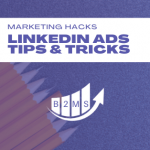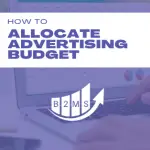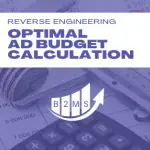LinkedIn Funnel: How to build a lead generation campaign that converts
It’s not just about the number of leads but also the quality. LinkedIn’s advertising targeting capabilities are very unique and especially effective for B2B marketers.
For this blog post we will break down the LinkedIn Sales Funnel into three stages: awareness, consideration, and converting.
Marketers should spend their time and money accordingly. It’s best practice to allocate the content and advertising budgets as follows:
- Awareness 60%
- Consideration 30%
- Converting 10%
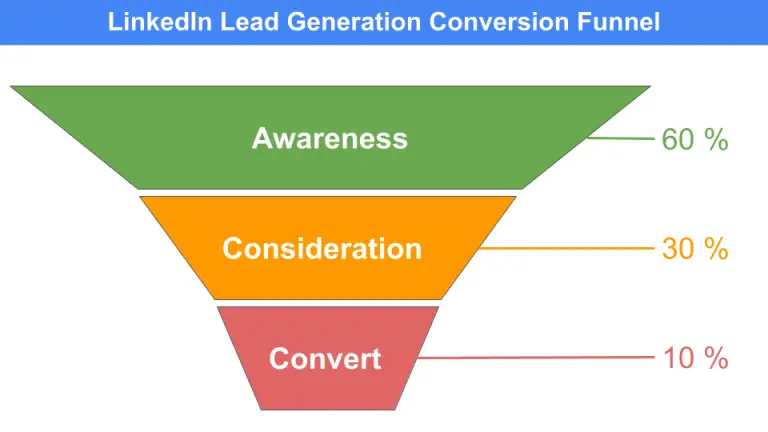
I know that many marketers will stop reading right here because they spend the majority of time, content, and budget on the converting stage. But those are the same marketers that don’t convert quality leads consistently on LinkedIn.
If you run one-off LinkedIn social network campaigns and ask your target audience to schedule a demo or start a trial you haven’t nurtured them at all. But let me ask you this: Would you do this on any other marketing channel?
Like any funnel or sales cycle, you lose people along the process and you need to account for that.
How to build a Linkedin Sales Funnel that converts
LinkedIn has many different campaign objectives and ad formats:
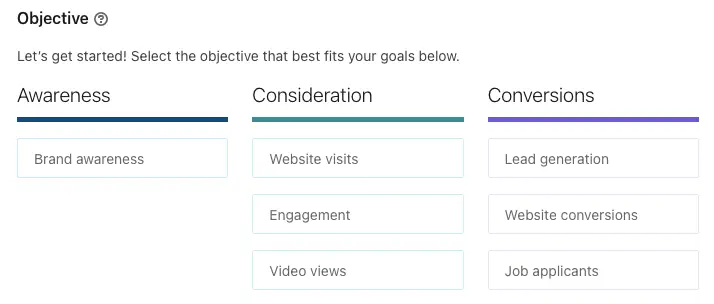
Marketers can choose different ad creatives for different objectives, but we will give you specific examples of when to choose which format. In fact, it’s sometimes less about the format rather than the message and goal (beyond the campaign objective).
When to chose the Brand Awareness Objective?
Even though we said we would like to spend 60% of our efforts on brand awareness, I never ever touch the brand awareness objective on LinkedIn. Why? Because I believe that the consideration metrics are better fits to measure brand awareness.
I usually pick website visits or video views depending on the ad format for brand awareness campaigns.
The differences to consideration campaigns, however, are the content and the call to action. For example, I run a video ad about an industry challenge and raise awareness of my brand, but run a video case study in the consideration stage instead. Both campaigns report video views but with a different message and goal.
How to run awareness campaigns on LinkedIn?
As mentioned above, I recommend choosing the video views for video ads and for everything else website visits.
I usually don’t use any very direct ad format like Message or conversation ads in this stage of the lead gen funnel.
My favorites are video and carousel ads for brand awareness because they are very engaging when done right. Additionally, they work very well towards my objective of video views and website clicks. Engaging carousel ads give you more chances for a click than one sponsored post.
Why I like video ads on LinkedIn so much is, that marketers can retarget viewers based on the consumption within LinkedIn’s platform. (More on that later in the example).
What are good examples for consideration campaigns on LinkedIn?
In the consideration or interest stage, it’s less about the problem and more about the solution – your solution. Case studies, comparisons, one-sheets, events, or free samples are great content examples.
Website views and video views are your best bet as consideration objectives on Linkedin. The only exception is when we try to create social content that should stay on social media like a discussion, then I would pick the engagement metric.
Which LinkedIn ad formats are best for which content piece?
In the consideration stage of the LinkedIn funnel advertisers can select a variety of ad formats:
- Single Image Ads
- Carousel Image Ads
- Video Ad
- Test ad
- Spotlight ad
- Message ad
- Conversation ad
- Event ad
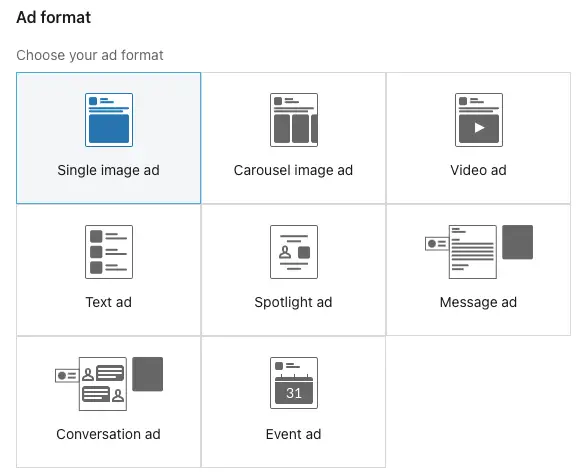
I usually recommend only six formats. To make it shorter, I don’t suggest using the text and spotlight ads. This is just personal preference and I’m sure they have advantages, too, but I rely on the remaining six formats.
First and foremost the ad format should follow the content, not the other way around. If you have the means to create content specific to LinkedIn’s format, I’m sure you don’t need this blog post.
So when should you choose which LinkedIn ad format?
- Sponsored Content in-feed ads: Single Image, Carousel Image, and Video ads are sponsored posts appearing in the news feed. You will need to grab the user’s attention in the very first seconds to stop her from scrolling and look at your content. All three formats are great but usually, carousel and video ads have a higher engagement.
- Sponsored Messages: message and conversation ads are sponsored messages in the inbox of the user. It’s a very direct approach that can be very effective. Especially, the engagement is very high due to the fact that they are less crowded formats. Additionally, LinkedIn guarantees the delivery. Marketers only “send” a conversation when a user logs into the platform. Compared to sponsored content, the prices are fairly new. This might be because the formats are fairly new. Marketers can send 100% delivered message ads starting at 15 cents per message. Sometimes it’s even hard to fulfill the daily campaign budget if the audience is narrow like specific job titles. I’d always include message ads (formerly sponsored InMails) into the campaign mix. Conversation ads are like chatbots within the LinkedIn inbox.
- Text and dynamic ad formats: text, spotlight, and follower ads (follower ads are available for brand awareness campaigns) are located at the right rail of LinkedIn’s feed. I usually don’t recommend those as they are easily overseen.
What’s a good example of a Linkedin lead generation funnel? (step-by-step)
Allocate 60% of your budget and content on awareness, 30% on consideration and 10% to convert leads and sales.
Step 1: Awareness campaign
In the case study, we use a video to create awareness. However, instead of choosing the awareness objective in LinkedIn, we choose video views under the consideration objective. That way, LinkedIn optimizes for video views and we can report accordingly.
Adjust your target audience and campaign details, add multiple video creatives (different videos and different creatives for the same video).
Step 2: Build a LinkedIn audience for remarketing
In this step, we will create multiple audiences for retargeting purposes within LinkedIn’s matched audiences:
Navigation Path: In your ad manager, head to Account Assets -> Matched Audiences. In there we create a new audience: create audience -> Retargeting by Video.
Now, we will create an audience for everyone who watched at least 25% of the video ad in the past 30 days. We will name the audience “Video Remarketing 25%” and select the video campaign we would like to use:

Please note, depending on your video lengths, 25% might be a lot or not meaningful at all. If you have a 20-second video, twenty-five percent is only 5 seconds of watch-time.
Either way, I recommend creating multiple audiences based on the engagement: 25%, 50%, 75%, and 97%. The higher the engagement the better the retargeting results.
LinkedIn will need 300 matched users to be able to activate the audience in the next step.
Step 3: Retarget video views in the consideration stage
You can set up three different campaigns using the same content: sponsored image and carousel ads as well as message ads. For instance, a case study works well. You can advertise the case study with one main image, some storytelling in the carousels, and a direct message to someone.
Bonus: If you have the case study in video format, replicate the process with video ads and retargeting just one step deeper into the funnel.
It’s also advised to link to a landing page to give engaged users the opportunity to learn more about your product or service. This allows them to convert when they are ready.
Step 4: Convert leads
Ask people for their contact info – ideally, with LinkedIn lead forms to have the sign-up process as easy as possible for users. Sponsored content and message ads work well for this. Just make sure you choose the lead generation objective to be able to add a LinkedIn lead gen form to it.
The difference to the consideration stage is the content offer. Now you are not giving content away for free. It’s about turning LinkedIn users into high-quality leads.
Read on for some further things you need to consider:
What do I need to consider when creating a LinkedIn campaign?
- Enough budget to test
- When testing, what’re the winning criteria?
- Do my lead generation forms ask for required information only?
- Are my LinkedIn leads connected to my CRM system?
- Do I have specific follow-up actions set up to nurture my new leads further?
- Can I apply the funnel to my ABM campaign?
- Do I have all creatives needed for the campaign, e.g. supporting images, follow-up emails, headlines, etc?
- Do my efforts support our Sales Development team?
- Is my LinkedIn profile and company page up-to-date?
- Will my campaign be profitable?

Sascha is a Lifecycle Marketing Consultant with over 8 years of digital marketing experiences in Silicon Valley, the UK, and Germany.
After leading the demand generation for a 100+ million company, he decided to venture out on himself. He’s now helping clients to attract and convert more leads and customers.
His main focus are SEO, paid media & marketing automation – all with the focus to tie marketing campaigns to revenue.
Sascha has been featured in industry publications.

